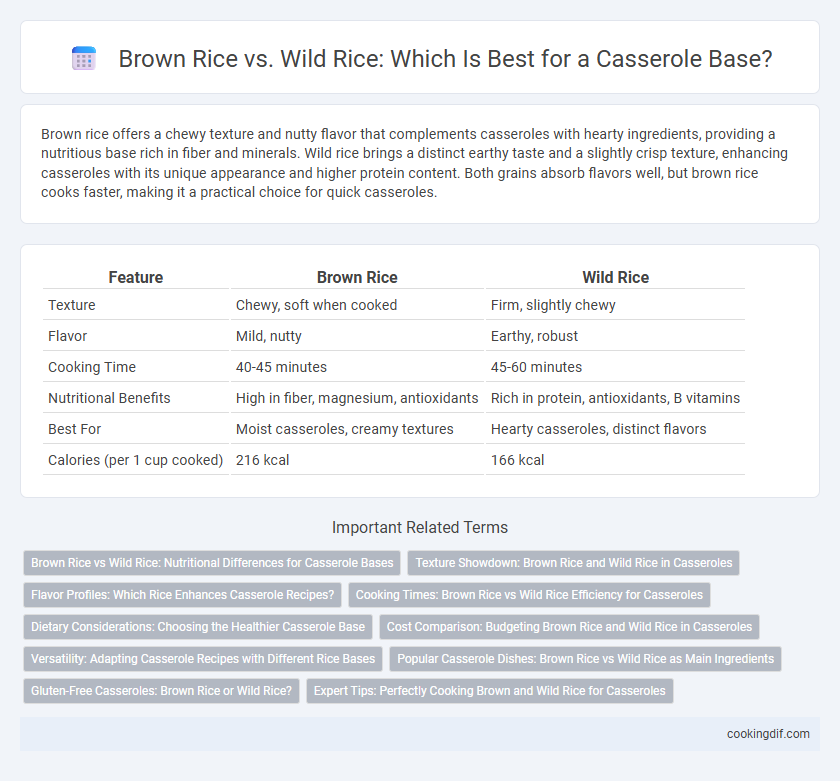Brown rice offers a chewy texture and nutty flavor that complements casseroles with hearty ingredients, providing a nutritious base rich in fiber and minerals. Wild rice brings a distinct earthy taste and a slightly crisp texture, enhancing casseroles with its unique appearance and higher protein content. Both grains absorb flavors well, but brown rice cooks faster, making it a practical choice for quick casseroles.
Table of Comparison
| Feature | Brown Rice | Wild Rice |
|---|---|---|
| Texture | Chewy, soft when cooked | Firm, slightly chewy |
| Flavor | Mild, nutty | Earthy, robust |
| Cooking Time | 40-45 minutes | 45-60 minutes |
| Nutritional Benefits | High in fiber, magnesium, antioxidants | Rich in protein, antioxidants, B vitamins |
| Best For | Moist casseroles, creamy textures | Hearty casseroles, distinct flavors |
| Calories (per 1 cup cooked) | 216 kcal | 166 kcal |
Brown Rice vs Wild Rice: Nutritional Differences for Casserole Bases
Brown rice offers a higher fiber content and essential minerals like magnesium and phosphorus, making it a nutrient-dense casserole base. Wild rice provides more protein and antioxidants, contributing to better immune support and overall health benefits in casseroles. Choosing between brown and wild rice depends on whether the priority is fiber-rich digestion or protein-enhanced nutrition.
Texture Showdown: Brown Rice and Wild Rice in Casseroles
Brown rice offers a chewy, slightly nutty texture that holds up well in casseroles, providing a hearty bite that complements creamy or saucy ingredients. Wild rice delivers a firmer, more fibrous texture with a distinct earthy flavor, adding a unique crunch and visual appeal to baked dishes. Choosing between brown and wild rice depends on whether you want a softer, more cohesive base or a contrasting, textured layer in your casserole.
Flavor Profiles: Which Rice Enhances Casserole Recipes?
Brown rice offers a nutty, slightly chewy texture that absorbs casserole flavors well, enhancing the dish with a subtle earthiness. Wild rice provides a more robust, earthy flavor with a firm texture, adding depth and a distinctive taste profile to casseroles. Choosing between the two depends on whether you prefer a milder base that complements ingredients (brown rice) or a bold, textured addition that stands out (wild rice).
Cooking Times: Brown Rice vs Wild Rice Efficiency for Casseroles
Brown rice typically requires about 40-45 minutes of cooking time, while wild rice takes longer, around 50-60 minutes, impacting casserole preparation efficiency. Choosing brown rice can significantly reduce overall cooking time without compromising the nutty flavor and chewy texture essential for casseroles. For time-sensitive recipes, brown rice offers a practical base that balances cooking duration with taste and nutritional value.
Dietary Considerations: Choosing the Healthier Casserole Base
Brown rice offers a higher fiber content and essential minerals like magnesium and selenium, aiding digestion and heart health, while wild rice provides more protein and antioxidants, supporting muscle maintenance and immune function. Both options are gluten-free and low in fat, making them excellent choices for health-conscious casserole bases. Selecting between them depends on specific dietary goals such as fiber intake or protein needs.
Cost Comparison: Budgeting Brown Rice and Wild Rice in Casseroles
Brown rice typically costs less per pound than wild rice, making it a more budget-friendly choice for casseroles without compromising on nutrition. Wild rice, while more expensive, offers a unique texture and flavor that can elevate the dish's appeal for special occasions or gourmet recipes. Selecting brown rice supports cost-effective meal planning while wild rice suits premium casseroles where flavor and presentation justify the higher price.
Versatility: Adapting Casserole Recipes with Different Rice Bases
Brown rice offers a hearty, nutty flavor and a chewy texture that enhances casseroles with its ability to absorb flavors well while maintaining structure. Wild rice provides a distinct, earthy taste and a firmer bite, making it ideal for casseroles that benefit from added texture and visual contrast. Both rice varieties adapt to a wide range of casserole recipes, allowing cooks to customize dishes for nutritional content, flavor profiles, and presentation.
Popular Casserole Dishes: Brown Rice vs Wild Rice as Main Ingredients
Brown rice offers a nutty flavor and chewy texture, making it a popular choice for hearty casseroles like chicken and vegetable bake, enhancing both nutrition and taste. Wild rice, prized for its earthy flavor and firm bite, is commonly used in traditional casseroles such as wild rice and mushroom or creamy wild rice and turkey, adding complexity and visual appeal. Both brown and wild rice varieties provide fiber-rich bases that elevate casserole dishes, catering to diverse flavor profiles and dietary preferences.
Gluten-Free Casseroles: Brown Rice or Wild Rice?
Brown rice and wild rice both serve as excellent gluten-free bases for casseroles, offering distinct textures and nutritional profiles. Brown rice provides a chewy, hearty texture rich in fiber and essential minerals, while wild rice delivers a nutty flavor with higher protein content and antioxidants. Choosing between them depends on desired casserole consistency and nutritional benefits, with both supporting gluten-free dietary needs effectively.
Expert Tips: Perfectly Cooking Brown and Wild Rice for Casseroles
Brown rice offers a chewy texture and nutty flavor that holds up well in casseroles, while wild rice provides a firmer bite and earthy taste, adding visual interest with its dark grains. Expert tips for perfectly cooking brown rice include rinsing thoroughly and using a 2:1 water-to-rice ratio, simmering gently to retain moisture. For wild rice, soak for at least 30 minutes before simmering in broth to enhance flavor and reduce cooking time, ensuring a tender but resilient texture ideal for layered casseroles.
Brown rice vs Wild rice for casserole base Infographic

 cookingdif.com
cookingdif.com